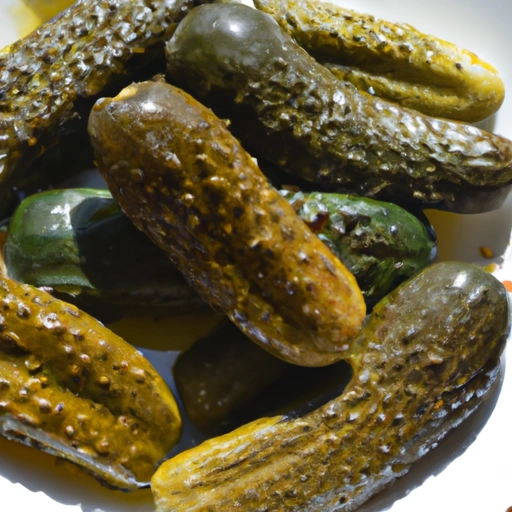Pickle
Description

Pickles are a food item made by preserving cucumbers or other vegetables in a solution of water, vinegar, and salt, often with various spices for added flavor. The pickling process can also include fermenting the vegetables in a brine that naturally encourages the growth of beneficial bacteria, which contributes to the distinct sour taste. Pickles come in many varieties, ranging from sweet to sour, and crispy to soft, depending on the pickling method and ingredients used.
Common uses
Pickles are commonly used as condiments, side dishes, and flavor enhancers in a variety of cuisines. They can add a zesty kick to sandwiches, burgers, and hot dogs, or provide a refreshing contrast in salads and platters. Pickles are also often served as an appetizer or a palate cleanser between courses in a meal.
Nutritional value
Calories
Typical pickles contain approximately 12 calories per 1 ounce serving (28 grams).
Protein
They offer a minimal amount of protein, roughly 0.3 grams per ounce (28 grams).
Fat
Pickles are generally low in fat, with only 0.2 grams per ounce (28 grams).
Carbohydrates
Most of the calories in pickles come from carbohydrates, specifically 2.7 grams per ounce (28 grams).
Vitamins
Pickles contain vitamin K and may have trace amounts of other vitamins depending on the vegetables used.
Minerals
They are a good source of minerals like sodium, potassium, and iron.
Health benefits
Pickles are rich in antioxidants due to the vegetables used and can provide probiotics if they are naturally fermented, which supports good gut health. The vinegar in pickles may also help regulate blood sugar levels.
Potential risks
While pickles offer health benefits, they can be high in sodium, which may be a concern for people with high blood pressure or heart conditions. Additionally, some pickles contain added sugars, which should be consumed in moderation.
Common recipes
Pickles are used in a wide array of recipes, from classic dill pickle spears to sweet pickle relish. They are also a main ingredient in dishes such as tartar sauce, potato salad, and various slaws.
Cooking methods
Pickles are most commonly used raw to maintain their crunch and tangy flavor, but can also be fried, as seen in popular Southern cuisine with fried dill pickles, or added to stews and soups for flavor.
Pairing with other ingredients
Their tangy flavor pairs well with rich and fatty foods such as barbecued meats, sausages, and cheese. Sweet pickles complement savory dishes and can balance spicy flavors.
Summary
Pickles are a versatile, flavorful ingredient enjoyed in countless dishes worldwide. They can enhance a meal both nutritionally and tastefully, though moderation is key due to their high sodium content. Used in myriad ways, from condiments to main dish accents, pickles are an indispensable part of global cuisine.